By Lindsay Boyle
On Thursday, July 12, the fourth International Mass Media summer course was held in Copeland Hall at the Ohio University campus. During each class, two SUSI scholars give a lecture about their own country’s media systems, journalism practices and political cultures. All of the lectures are streamed live through Ohio University distance learning and are available online to 35 students who are taking a summer class instructed by Dr. Brook Beshah.
The SUSI summer institute — in which scholars from all over the world come to the E.W. Scripps School of Journalism at OU to study journalism and media — is funded by an annual renewable grant from the U.S. Department of State’s Study of the U.S. Branch in the Office of Academic Exchange Programs.
Dr. Murad Abdullah
Yemen
To kick off his presentation, Dr. Murad Abdullah, the scholar from Yemen, began with an overview of the Yemeni political structure.
Abdullah explained that about 16 months ago, just one man — who claimed the government was a republic — essentially ruled Yemen. During that time, Abdullah explained that news was predictable — there was no criticism of basic government policy, except for complaints about lower-level government employees.
However, in 2011, the Yemeni Revolution ultimately brought a new leader into power. In Yemen today, Abdullah explained that there are five main types of media: government-controlled, party-affiliated, international, independent and social.
The government-controlled media includes two TV channels and several radio channels, as well as some print outlets. Today, the press is used primarily as a tool of political mobilization of the public.
There are several different party-affiliated media, which are run and sponsored by political parties. Abdullah explained that those media typically target the ruling regime with heavy criticism. They publish issues directly concerning their members, and often neglect human rights issues. However, Abdullah said that party-affiliated media did play a positive role throughout the Yemeni Revolution.
Independent media in Yemen is complicated. Though there are many different TV and radio channels, Abdullah said they are often aired from elsewhere, such as London or Egypt. That is changing as the constitution, reviewed by the new government, now allows more freedom.
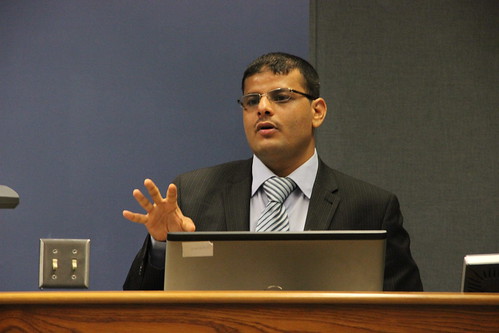
SUSI scholar Dr. Murad Abdullah presents a lecture that is streamed live through OU distance learning, and is available online.
Abdullah explained that there are also independent newspapers, but though professional journalists run them, parties are sometimes behind them. Such papers often tackle only certain issues and help certain parties.
Finally, there are truly independent media, which Abdullah said are preferred by the public. However, he explained that because many journalists do not know much about business management, such media often close down. Additionally, there is not always a lot of fact checking, which can lead to coverage of false information.
During the Yemeni Revolution, Abdullah said that social media were active and vibrant. Though social media did not cause the revolution, he said they did help it continue. Regardless, Abdullah pointed out that users of social media are still a minority in Yemen, and that social media can also have credibility issues.
Ultimately, Abdullah is not optimistic about the future of independent media, but is optimistic about that of governmental media. He said he believes that the latter have truly divorced from the past regime and no longer want to be the tool of a ruler. He also explained that Yemen’s new president seems genuinely willing to bring about change.
Although he prepared for his presentation one day prior to it, Abdullah said he had gathered the information for it while he was still in Yemen. For him, it was not difficult to present in front of his colleagues. However, he did mention some challenges.
“What is special about the event is that it is a new environment and a new audience,” he said. “I had the challenges of deciding how to make the information focused and concentrated to the media in Yemen, and how to give information that the audience would understand easily, as they don’t have background about the country of Yemen.”
Prof. Rachael van der Kooye
Suriname
Scholar Rachael van der Kooye, from Suriname, began her presentation with an introduction of herself, as well as an overview of her country. She explained that Suriname has a very culturally diverse population and that, for the most part, the different groups live in peace with one another.
She said that, in the past, a violent and unfriendly media culture existed in Suriname. However, that culture mostly disappeared after a nearly five-year-long civil war ended in 1992.
Suriname is a republic in which presidents are elected to five-year terms. However, the current president, Desi Bouterse, is controversial and has been accused of killing political opponents.
As far as Suriname’s media is concerned, van der Kooye explained that several TV stations, radio channels, newspapers, magazines and Internet news sites exist, and are owned by a mixture of the government, private groups and political parties.
In Suriname, multiple governmental ministries are responsible for media regulation, which includes granting licenses, dealing with legal matters and property rights, and more.
Despite the regulation, van der Kooye said that journalism suffers from many different things. Media owners rarely pay attention to quality; unprofessional conduct and propaganda are frequent; there is a lack of ethical principles, journalistic training and investigative journalism, and journalists are usually overworked and underpaid.
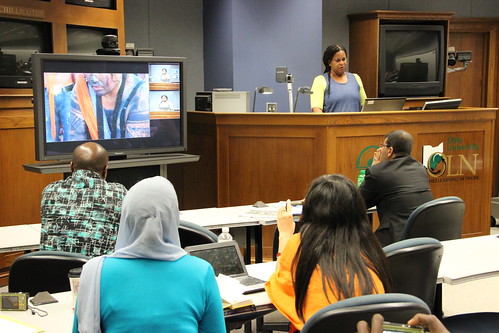
SUSI scholars and staff listen as scholar Rachael van der Kooye presents a lecture that is streamed live through OU distance learning, and is available online.
Additionally, the history of human rights violations in Suriname caused many journalists to be murdered or imprisoned, or to flee the country, according to van der Kooye.
Because media have been discovered as a way to gain power, influence and money, there has been an explosion of media within the past five years.
Often, journalists are politically affiliated, which disrupts objectivity and independence, according to van der Kooye. Many journalists limit themselves by simply copying press releases and by asking few or no critical questions. That occurs because those who ask critical questions can receive threats.
Suriname’s current government cultivates an image of fear not only through threats, but also through intimidation and boycotting media, van der Kooye said. Journalists are also limited in that the government does not openly provide information to them.
Ultimately, although press freedom is a constitutional law in Suriname, the majority of media operate under a system of self-censorship.
At the end of her presentation, van der Kooye warned that journalists in her country and others should remember that politicians often do not like journalists themselves, but rather the influence that journalists have.
“I don’t want to be a politician to change things, I want to be a teacher,” she said, bringing about applause from the audience.
Tuesday, July 31, 2012
International Mass Media: July 12
Topics: International Journalism, Ohio University, Suriname, SUSI, Yemen
Monday, July 30, 2012
International Mass Media: July 11
By Lindsay Boyle
On Wednesday, July 11, the third International Mass Media summer course was held in Copeland Hall at the Ohio University campus. During each class, two SUSI scholars give a lecture about their own country’s media systems, journalism practices and political cultures. All of the lectures are streamed live through Ohio University distance learning and are available online to 35 students who are taking a summer class instructed by Dr. Brook Beshah.
The SUSI summer institute — in which scholars from all over the world come to the E.W. Scripps School of Journalism at OU to study journalism and media — is funded by an annual renewable grant from the U.S. Department of State’s Study of the U.S. Branch in the Office of Academic Exchange Programs.
Prof. Taimoor Noori
Afghanistan
In his presentation, Taimoor Noori first described the reach of various types of media in Afghanistan, explaining that both commercial and state-owned TV and radio are currently the most prominent and effective.
Though media on the Internet does impact what appears on TV and radio, Noori said that its reach is minimal throughout his country.
Print publications are doing the least well of all formats, which Noori said is likely due to the low levels of literacy in the country. Afghanistan has no official national newspaper.
In addition, Noori explained that citizens overall are deprived of many media outlets because the current regime does not allow them. However, because of the large amount of international troops stationed in Afghanistan, he said that several international news organizations are present, though they come and go.
Noori himself works for the New York Times doing correspondence about an ongoing war. He explained that the presence of such international publications is important, because their criticism of the current regime encourages local outlets to do the same — something he said he feels could bring about change.
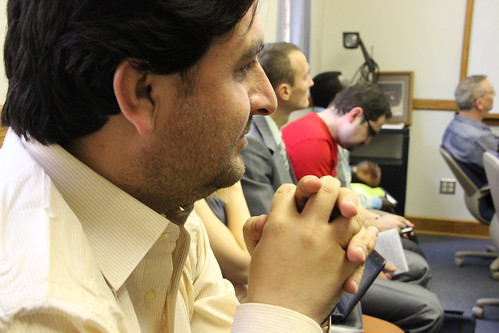
SUSI scholar Taimoor Noori listens to a speaker during a morning class.
When local journalists criticize the government, however, it is not without risk. Although there is no official censorship in his country, Noori said threats from the reigning regime have become increasingly common in recent years. Such threats range from detainment to lawsuits to assassination attempts.
In addition, Noori explained that the government sometimes denies the stories written by journalists by saying the journalists are spreading rumors and lies, or that they are spying for Iran or Pakistan. Such comments can endanger the journalists’ lives and tarnish their reputations.
Also working against the journalists — or at least the ones who work for Western media — is that many Afghans believe Western media work for their own interests, not to bring change in Afghanistan. According to Noori, many Afghans also believe that Western alliance forces have misled them by not making good on their promises to bring peace, stability and prosperity to Afghanistan.
Overall, Noori described most people in Afghanistan as being critical of the government, logical and open-minded. He said that they may need organizational help and assistance to create a more peaceful and stable nation, but otherwise would prefer to no longer be disrupted.
Dr. Alexsandr Kazakov
Russia
SUSI scholar Dr. Alexsandr Kazakov began his presentation with a brief introduction of his institution, Saratov State University.
Afterward, he explained his hopes to learn more about the United States, as well as his desire to dispel some existing stereotypes about Russia. He mentioned some of those stereotypes and how they were not true for him, which brought about laughter in the classroom.
Kazakov then transitioned into a brief history of media development in Russia in the 20th century, from media under leader Joseph Stalin, to Nikita Khrushchev, and onward.
In Russia today, Kazakov explained that the main sources of information are, in order, TV, print, Internet and then radio. He said that national, regional and local levels of media are pretty evenly split.
After explaining that there are more than 26,000 papers in circulation, Kazakov reminded his audience that Russia is a huge country with a large population. He said a good aspect of that is that there is no existing monopoly of information or opinion in Russia.
According to Kazakov, there are two primary approaches to media in Russia, and most Russian media outlets fall somewhere in between the two.
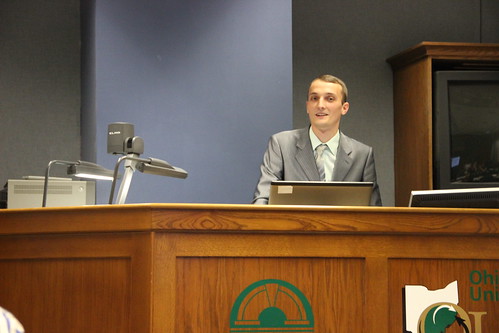
SUSI scholar Dr. Alexsandr Kazakov presents a lecture that is streamed live through OU distance learning, and is available online.
He said the first approach is one that is critical of the current regime and affiliated with the opposition. In 2000, Kazakov explained that the government started to gag that form of media by banning several national TV channels and papers, forcing some journalists to resign, and forbidding live political talk shows. Russian media is far from free, according to Kazakov.
However, he said the second approach is state-oriented, but does not have state censorship. Instead, it is a quickly rising independent media system that holds press freedom as a key value. Regardless, Kazakov explained that many outlets still think that it is better to generally support the government than to criticize it, or to follow Western interests.
Overall, Russian media fall in a mixed category that is transitioning. More and more outlets are trying to push the limits of what they can cover. That is possible especially through Russia’s uninhibited Internet.
In Russia, social media are becoming more popular, but only among youth, Kazakov said. Despite the small age range using the medium, Kazakov explained that social media still affects politics in Russia. Aside from social media and the Internet in general, though, he said the influence of outside Western media is limited.
Kazakov spent much time prior to the presentation preparing, and said that he felt a bit anxious. Ultimately, however, he said that everything went well.
“I think that every scholar feels anxious, and has butterflies in his or her stomach," he said. "But when it comes to presenting, it’s OK, because the atmosphere is very nice, it’s very calm, and nobody asks you very difficult or rude questions.”
Topics: International Journalism, Ohio University, Russia, SUSI
Sunday, July 29, 2012
Uncharacteristic crashes mar London Olympic men's cycling road race
 |
| Photo by Kayla Hanley Iran Olympic Cyclist Amir Zargari was injured during a collision near the Box Hill entrance of the Men's Cycling Road Race. |
 |
| Photo by Kayla Hanley Peloton riding towards Box Hill |
Topics: Amir Zargari, Box Hill, Buckland, London Olympics 2012, Peloton, Redhill, Surrey
Bang for the Buck(ingham Palace): Olympics start in London with Opening Ceremonies
 |
| Viewers gather in the Duke of York Square to watch the Opening Ceremonies. BBC reported more than 27 million viewers for the ceremonies, |
Saturday, July 21, 2012
A visit to Cleveland’s oldest black-owned newspaper Call & Post
By Rachael van der Kooye
At the beginning of this week was the first of the three cultural tours offered to the SUSI scholars on media and journalism by the E.W. Scripps School of Journalism, a faculty of Ohio University.
 |
| Visiting Call & Post |
The inventor
Morgan was the son of former slaves, born in Paris, Kentucky on March 4, 1877. While still a teenager, he left Kentucky and moved north to Cincinnati, Ohio in search of opportunity. In 1895 Morgan moved to Cleveland, Ohio, where he went to work as a sewing machine repair man for a clothing manufacturer. In 1907 he opened his own sewing equipment and repair shop. It was the first of several businesses he would establish. In 1914 he invented a device called the Morgan safety hood and smoke protector, now called the gas mask.
On July 25, 1916 Morgan made national news for using his gas mask to rescue 32 men trapped during an explosion in an underground tunnel 250 feet beneath Lake Erie. Morgan and a team of volunteers donned the new 'gas masks' and went to the rescue. After the rescue Morgan's company received requests from fire departments around the country who wished to purchase the new masks. But when people found out that it was a black man who invented the gas mask they stopped buying them. "They rather let their people die than rescue them by a gas mask of a black man," Harper explained in a conversation with the SUSI scholars. According to her Morgan established the Cleveland Call in 1920 to publish his invention. Morgan is also the inventor of the traffic signal and the zig-zag stitching attachment for manually operated sewing machine.
One of the most influential voices
 |
| Conny Harper edits reports at her desk |
International Mass Media: July 10
By Lindsay Boyle
On Tuesday, July 10, the second International Mass Media summer course was held in Copeland Hall at the Ohio University campus. During each class, two SUSI scholars give a lecture about their own country’s media systems, journalism practices and political cultures. All of the lectures are streamed live through Ohio University distance learning and are available online to 35 students who are taking a summer class instructed by Dr. Brook Beshah.
The SUSI summer institute — in which scholars from all over the world come to the E.W. Scripps School of Journalism at OU to study journalism and media — is funded by an annual renewable grant from the U.S. Department of State’s Study of the U.S. Branch in the Office of Academic Exchange Programs.
Prof. Divine Bisong
Cameroon
At the beginning of scholar Divine Bisong’s presentation, he first pointed out the location of Cameroon in Africa. He then explained that although Cameroon is technically a republic, its government actually aligns more closely with one that is libertarian or authoritarian.
Bisong said that governmental interference, among other things, has caused the basic values of journalism to be flouted with impunity in Cameroon. Stories there are treated unprofessionally, according to him.
For many media, Bisong said that costs of publication can be up to 50 percent of income, leaving the rest to not only pay staff salaries, but also to make a profit. As a result, he explained that many journalists in Cameroon quickly become “academic prostitutes,” hopping from publication to publication in search of the best salary. Such practices cause journalists to have little loyalty to the company they are writing for, and to pay little attention to detail in the stories they produce.
In addition, Bisong said that some journalists get so caught up with politicians that it is hard to tell the difference between the two. Some journalists engage in writing stories with clear conflicts of interests. Others are completely used by politicians as a stepping stone for ulterior motives.
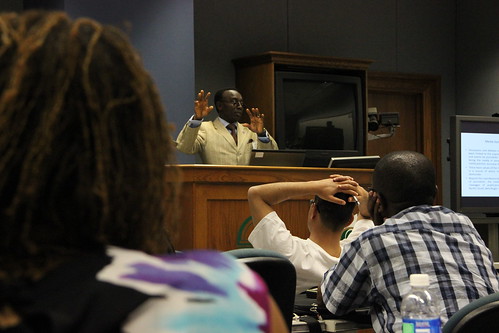
SUSI scholars and staff listen as Prof. Divine Bisong presents a lecture that is streamed live through OU distance learning, and is available online.
To make matters worse, Bisong said that Cameroon has no overarching union or association delegated to regulating the news. The lack of rules often leads to “news” that is twisted in the way the writer wants it to be rather than how it actually is, he explained.
One plus, according to Bisong, is that new media is growing at a remarkable rate. Forty percent of Cameroonians have mobile phones, and Internet penetration is increasing.
Regardless, the environment is still hard for journalists, and especially women. According to Bisong, women struggle to obtain significant positions. If they happen to work hard enough to do so, they face trouble with their husbands and families, because Cameroon is still a largely paternalistic nation.
Ultimately, Cameroon’s media atmosphere is quite repressive. Bisong explained that most media are pro-government, and most journalists employ self-censorship to avoid governmental threats or even imprisonment. Bisong himself said he has been detained in the past.
A monopoly in the printing sector of things means that stories seen as unfit are simply not printed. Additionally, Bisong said that critical, in-depth investigative journalism is difficult in Cameroon, because sources are not always credible, and many people are denied the right to information from governmental and other organizations.
“Media is a weapon to be guarded against rather than a vital pillar of a democratic state,” Bisong said.
Prof. Silvia Callejas
El Salvador
Scholar Silvia Calleja first offered a personal introduction, explaining what she has done in her past and current editing and teaching jobs. As a teacher, she said she strives to make media theory and public relations more interesting and fun for her students.
Callejas then gave a brief overview of El Salvador, followed by a history of El Salvadoran media throughout the years. She first focused on its first national print publication, which began in the 1800s and has changed names several times.
That publication had the goal of criticizing authoritarians, Callejas explained, and though it was censored at one point, it continued publishing. During the Salvadoran Civil War, however, its writers were threatened and its building was burned.
When word of that turmoil spread, the publication received national and international help, according to Callejas. It is still running today as a private paper called the Co-Latino.
Though it is the oldest, Co-Latino is not the biggest publication in El Salvador. Callejas explained that there are two major papers in El Salvador, and that only four publications hold 92.2 percent of the Salvadoran readership.
A problem with one of those prominent publications — Mas! — is that it targets the lowest social class in El Salvador, and therefore is more sensationalistic than realistic.
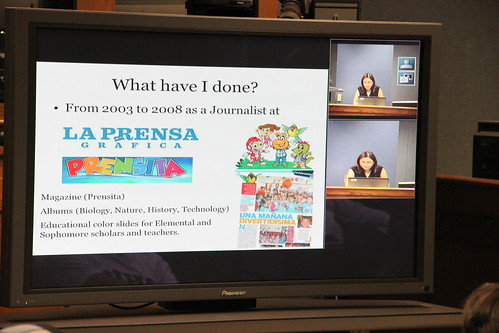
The view seen by those following Prof. Silvia Callejas’ lecture online or through OU distance learning.
To help combat the existing media oligopoly, the Association of Radio and Participatory Programs of El Salvador has been helping community radio stations to get a start in an environment that sometimes makes doing so difficult.
In addition to print publications, Callejas said there are magazines targeted at many different audiences, four radio corporations that are more likely to cover entertainment than news, and television stations that are mostly syndicated. Some publications, such as La Prensa Grafica, are also exploring the online world with the hope of reaching an international audience.
Throughout the years, censorship in El Salvador has been based on the government in power, Callejas said. The constitution says that people are free to make their own opinions, and the ability for people to do so in 2012 is much better than it was in the 1980s. The evolution of media in the digital world — including citizen journalism and social media — has only expanded that ability.
According to Callejas, some journalists in El Salvador are big critics of the government. Though journalists sometimes receive orders not to publish, Callejas said that that practice is becoming less frequent. Regardless, she explained that, if important people are involved, there are still some situations in which scandals go unreported.
Callejas said that she used a combination of Internet searches, past research and class materials to compose her picture-filled presentation.
“At the beginning of the presentation, I was really nervous because it is really difficult to think in Spanish and try to translate, but I tried to write a script before so I could remember most parts of the presentation,” Callejas explained.
However, she quickly settled in, and said that by the end she “felt really good.”
“I think that time ran out faster than I thought it would,” she said.
Topics: Cameroon, El Salvador, International Journalism, Ohio University, SUSI
Friday, July 20, 2012
First impressions
SUSI scholars visit Little Cities of Black Diamonds
By Lindsay Boyle
The 2012 SUSI scholars visited several of the Little Cities of Black Diamonds and learned about the history of the southeast Ohio region on July 15.
The SUSI summer institute — in which scholars from all over the world come to the E.W. Scripps School of Journalism at Ohio University to study journalism and media — is funded by an annual renewable grant from the U.S. Department of State’s Study of the U.S. Branch in the Office of Academic Exchange Programs.
The scholars experienced a tour provided by the Little Cities of Black Diamonds Council. It included attractions in the towns of Nelsonville, Haydenville, New Straitsville and Shawnee.
Scholar Dr. Wilberforce Dzisah said he was glad to be able to see a rural side of the U.S., because people are not typically interested in anything outside of the “glittering city life.”
“I’m really thrilled by what I’ve seen today,” he said. “It’s amazing, the rural side of the most powerful nation on earth.”
The tour began in Nelsonville’s public square, where the scholars heard a brief history of coal mining in southeastern Ohio. Nelsonville was founded in 1869, making it the oldest of the Little Cities of Black Diamonds.
The scholars were then driven through Haydenville, where they saw a round house on the National Register of Historic Places, the Haydenville United Methodist Church, which was built from five different materials, and other attractions.
Just outside of New Straitsville, the scholars observed a historic African American cemetery called Payne Cemetery. Payne Cemetery is a resting place for several African Americans from the South who had helped to create the now defunct community of Payne’s Crossing just before the Civil War.
At the cemetery, the tour guide briefly explained the sides of the Civil War, as well as concepts such as the Underground Railroad.
In New Straitsville, the scholars saw the New Straitsville United Methodist Church, Robinson’s Cave and the New Straitsville History Museum.
Robinson’s Cave is a small cave in the woods of New Straitsville where upset miners met secretly in the late 1800s. The history of Robinson’s Cave was explained through a living history method, in which Ron Luce impersonated Christopher Evans — the New Straitsville resident who led the meetings in the cave — and spoke about the happenings in the cave from Evans’ point of view.
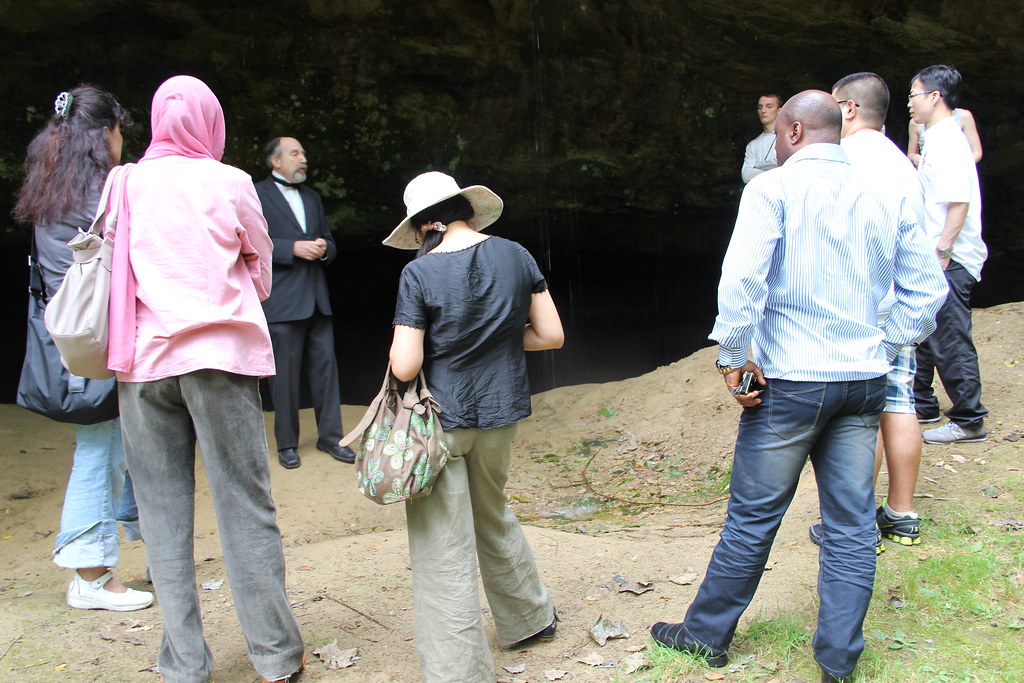
Ron Luce, a tour guide impersonating Christopher Evans, speaks about the history of Robinson’s Cave.
The scholars learned that the meetings ultimately led to the Hocking Valley Coal Strike, as well as the formation of both local and national mine worker unions.
At the New Straitsville History Museum, the scholars first saw an outdoor mural depicting the history of the area. Inside, they observed many things that commemorated union organizing, mine fires, oil drilling and more, including old mining tools and blueprints of plans to stop the mine fires.
The final stop of the tour was in Shawnee. There, the scholars had lunch at a multi-purpose building called Tecumseh Common and then heard an overview of Sunday Creek Associates from two of its founding associates, John Winnenberg and Sandy Landis.
The SCA acts primarily as a community organizer for the southeast Ohio region. One of its goals is to aid community development projects in the area, which is one of the poorest regions in Ohio. The tours of the Little Cities of Black Diamonds, organized by the Little Cities of Black Diamonds Council, are one such project.
Winnenberg helped found the Little Cities of Black Diamonds Council in the early 1990s with the goal of preserving local history and coal town structures. He, along with Rob Dishon, helped lead the scholars’ tour.
The scholars also had some free time to observe the Tecumseh Theater, the Hocking Valley Coal Miner statue and local shops.
The Tecumseh Theater, which is the tallest building in Perry County, was opened by a fraternal organization in 1907. Though it closed in the 1950s, there is currently a movement to renovate and reopen it.

Scholars pose next to the Hocking Valley Coal Miner statue in Shawnee, Ohio.
Friday, July 13, 2012
International Mass Media: July 9
By Lindsay Boyle
On Monday, July 9, the first International Mass Media summer course was held in Copeland Hall at the Ohio University campus. During each class, two SUSI scholars give a lecture about their own country’s media systems, journalism practices and political cultures. All of the lectures are streamed live through Ohio University distance learning and are available online to 35 students who are taking a summer class instructed by Dr. Brook Beshah.
The SUSI summer institute — in which scholars from all over the world come to the E.W. Scripps School of Journalism at OU to study journalism and media — is funded by an annual renewable grant from the U.S. Department of State’s Study of the U.S. Branch in the Office of Academic Exchange Programs.
Dr. Wilberforce Dzisah
Ghana
Dr. Wilberforce Dzisah began his presentation with a brief history of media in Ghana. He emphasized the struggles of newspapers and other media outlets through the many dictatorships and totalitarian regimes that existed in Ghana between 1957 — when it gained independence — and 1992.
In Ghana today, however, Dzisah explained that media often lean liberal or even socialist. He said that it is not unusual for media stories — especially those of private media — to criticize governmental actions. Ghana’s constitution, unlike the constitutions of some other African countries, allows freedom of the press and prohibits censorship.
A regulatory body called the National Communications Authority is responsible for granting licenses, authorizing operations and establishing and monitoring the quality of media services in Ghana.
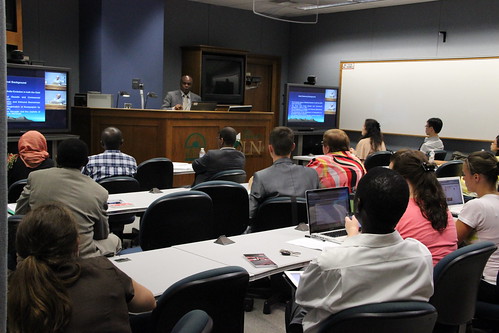
SUSI scholars and staff listen as Dr. Wilberforce Dzisah presents a lecture that is streamed live through OU distance learning, and is available online.
According to Dzisah, some media outlets in Ghana are state-owned, while others have private ownership. He explained that, until 2000, those that were state-owned were the biggest threat to journalistic freedom, because an existing criminal libel law allowed politicians to frequently raise lawsuits against journalists.
In 2000, however, new leadership repealed that law. Dzisah said that the responsibility of media in Ghana has now mostly shifted toward ensuring democratic accountability and responsibility. Dzisah explained that Ghana’s political system is called a parliamentary democracy.
In Ghana, there are about 100 newspapers in circulation, and radio is still a very prominent medium. Though the Internet is not yet a primary method for obtaining news in Ghana, Dzisah said that the amount of people in Ghana who are joining the online world is increasing.
Dr. Aysha Abughazzi
Jordan
In scholar Dr. Aysha Abughazzi’s overview of Jordan, she explained that it became independent in 1946 and is currently under a constitutional monarchy.
Abughazzi went on to explain the different types of media in Jordan, which include news agencies, broadcast stations, public television and several kinds of printed publications. She said that media in Jordan can be either publicly or privately owned.
Jordanians, however, are less likely to rely on TV and radio than on printed publications, according to Abughazzi. That is because the government sometimes monitors TV and radio groups, such as the Jordan Radio and Television Corporation, quite closely.
Jordan’s first newspaper launched in 1936 and was printed in Palestine. Abughazzi said that, today, daily newspapers are the most trusted by Jordanians, followed by weekly papers, then online publications. Because a censorship of sorts — self-censorship by journalists — exists in Jordan, Abughazzi explained that people there are likely to read both state and private papers in order to obtain news.

Dr. Aysha Abughazzi gives a vote of thanks speech at the SUSI Welcome Dinner.
In 1997, one of the strictest publication laws in Jordan's history allowed the government to jail journalists if it did not approve of what they wrote. However, that law was outlawed within a few years of its endorsement. Regardless, many journalists still practice self-censorship concerning topics sensitive to Jordanian ethics or morals, or to the king, for fear of governmental threats of fines, detention or otherwise.
Despite such infringements on the freedom of the press, Jordan’s high literacy rate and high level of technological connectivity allow its citizens to have several sources of information. Many events are covered, and social media often play a role in what those events are.
So far, Abughazzi said she has enjoyed everyone's International Mass Media class presentations, because she has been learning about things she may not have otherwise learned.
“I thought that their presentations were enlightening,” she said of fellow SUSI scholars. “The fact is that sometimes you have certain stereotypes, you’re an outsider, you don’t know how things go on, but now you have somebody to disillusion those ideas.”
Topics: Ghana, International Journalism, Jordan, Ohio University, SUSI
Tuesday, July 10, 2012
SUSI 2012: The first three days
By Lindsay Boyle
The 2012 SUSI scholars arrived safely in Athens, Ohio on July 5 and 6, and the program is now underway.
The SUSI summer institute — in which scholars from all over the world come to the E.W. Scripps School of Journalism at Ohio University to study journalism and media — is funded by an annual renewable grant from the U.S. Department of State’s Study of the U.S. Branch in the Office of Academic Exchange Programs.
Beginning on July 5 at noon until about 2 a.m. the following day, the scholars arrived at the Port Columbus International Airport, where SUSI program director Dr. Yusuf Kalyango and program assistant Sally Ann Cruikshank greeted them.
“It was a very, very long flight, and with three transits I was so exhausted. The moment I arrived (at the Columbus airport) and I saw Dr. Yusuf and Sally Ann there, it was like their faces made a message like feeling home,” Pakistani scholar Aazadi Burfat said. She added that the warm welcome they gave was “so good to have, and so memorable, and I will keep it with myself for all of my life.”
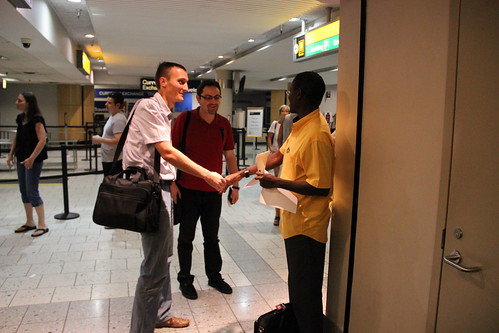
Scholars Dr. Alexsandr Kazakov and Dr. Suren Deheryan greet Dr. Yusuf Kalyango.
Transportation to Athens was provided by a rotation of program assistants Camilo Perez, Jim DeBrosse and Ashley Furrow. Five trips were made, typically with three to five scholars riding in each van.
Once they arrived in Athens, the scholars were taken to University Courtyard, an apartment complex where they would reside throughout their time in Athens.
At the complex, the scholars met a combination of program assistant Lindsay Boyle, and either academic director Mary Rogus or assistant academic director Dr. Aimee Edmondson. Those SUSI staff members provided brief apartment tours for each of the scholars and worked to answer any questions that arose.
“When I arrived at Columbus, I was really happy to see Sally Ann waiting and waving my name. That made me feel at home,” Jordanian scholar Dr. Aysha Abughazzi said. “I was also happy to see that, although we arrived late, we had Lindsay waiting for us and showing us our apartments and rooms. It kind of made me feel relaxed.”
Scholar Dr. Ibaa Awad, from Sudan, said that she also was, and continues to be happy with the SUSI staff. “The people are generous, so generous with us, and a number of people ask about how we’re doing in the apartments and they look after us,” she said.
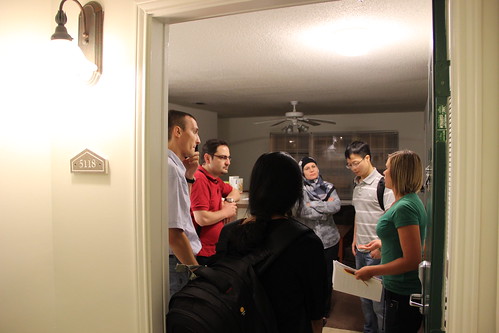
Program assistant Lindsay Boyle gives the scholars a tour of their apartments.
Though most of the scholars had commutes that were 15 hours or longer, many of them also appeared relaxed and in good spirits upon their arrivals.
Dr. Huei Lan Wang, a scholar from Taiwan, said that she was able to overcome the tiredness and maintain a good mood because of the reception from the SUSI staff members. “I think that even though the body’s tired, you could feel this real warmth from the SUSI program, and the people from the SUSI program,” she said.
Scholar Hugo Zarate, representing The Bahamas, said that he felt safe when he arrived in Ohio, and continues to feel that way. “When you come to a place that you don’t know, sometimes you don’t know what to do, but I’ve had a good experience here in the apartments with my new colleagues and friends,” he said.
This is Cameroon scholar Divine Bisong's first time visiting the United States for an academic program of SUSI’s nature, and he said that he has had a great experience thus far. “I think getting to Ohio, I discovered some kind of a legendary hospitality of the people right from the airport,” Bisong said. “All in all, the accommodation is pretty commendable. Up till now, I think I’m in the right place and I feel very grateful for that.”
El Salvadoran scholar Silvia Callejas said that she also enjoys both the apartments and the members of the SUSI staff. “All of you have done a really good job to make us feel comfortable and we don’t miss our countries and even our homes,” she said.

The scholars enjoy a breakfast provided by the SUSI staff.
After the scholars had a chance to catch some sleep, they began July 6 with a breakfast provided by the SUSI staff that featured dishes cooked by both Rogus and Edmondson.
The remainder of that day was spent on logistics such as signing leases and obtaining OU identification cards. In addition, the scholars were given a brief tour of the OU campus, and taken into town to go shopping.
Saturday, July 7 brought about the scholars’ first academic session, as well as their first official orientation. It was led by both Kalyango and assistant administrative director Jean Marie Cackowski-Campbell.
During the session, the scholars learned about the technology they would be using during the SUSI program, such as Blackboard, Twitter, and the Institute for International Journalism’s blog. The orientation covered things such as rules, regulations, logistics and what to do in case of an emergency.
Scholar Alexandre Twizeyumukiza, from Rwanda, said that he liked the session and orientation. “I have so much appreciated how we’ve been oriented, how we’ve been received here at Ohio University. The people who have received us are very kind,” he said. “In short, when I am here, I feel as I’m home.”
Scholar Karlyga Myssayeva, from Kazakhstan, found the orientation to be useful. “I would like to say thank you for the SUSI program, especially director Yusuf and all the staff, because this orientation week was very helpful for us, and I think it was necessary for us because we found all the answers for our questions,” she said.

Scholars listen as Dr. Yusuf Kalyango leads an orientation session.
On Saturday night, a welcome dinner organized by SUSI staff members served as the official kick-off of the SUSI program. Several Scripps faculty members, as well as other special guests joined the SUSI scholars for the dinner.
OU President Dr. Roderick McDavis provided what multiple SUSI staff members described as a thorough and heartfelt keynote speech, which covered the prominence of internationalism at OU and the importance of it worldwide.
Throughout the night, those in attendance also heard from Kalyango, Rogus, E.W. Scripps School of Journalism Director Dr. Bob Stewart, Scripps College of Communication Interim Dean Dr. Scott Titsworth, and adjunct professor Dr. Brook Beshah.
“(The dinner) was even better than I expected because I enjoyed the communication, I enjoyed the meal, I enjoyed the atmosphere, I enjoyed the speeches,” said Dr. Alexsandr Kazakov, a scholar from Russia. “It was great.”
At one point, Abughazzi addressed the attendees with a vote of thanks — a short speech that thanks individuals and often calls for the audience to thank them as well — to recognize those who made both the dinner and the SUSI program possible.
Scholar Bogdana Nosova, from Ukraine, said that she enjoyed every minute of the welcome dinner. “It was an excellent possibility to meet so many colleagues at one time, in one place and to discuss with them,” she explained. “I sincerely appreciate and am grateful to all the people who made that perfect evening possible.”
Topics: International Journalism, Ohio University, SUSI
Sunday, July 1, 2012
2012 SUSI scholars prepare for the program
By Lindsay Boyle
IIJ Ambassador
As July’s launch of the 2012 Study of the U.S. Institute on Journalism and Media nears, the 18 scholars that were chosen this year are busy with preparations and full of expectations.
The SUSI summer institute — in which scholars from all over the world come to the E.W. Scripps School of Journalism at Ohio University to study journalism and media — is funded by an annual renewable grant from the U.S. Department of State’s Study of the U.S. Branch in the Office of Academic Exchange Programs.
Because the program runs from the beginning of July to late August, many of the institutions that the scholars work at are not in session.
Additionally, August in particular is a month that is often devoted to holiday — a time period in which employees receive paid time off from work — for workers in many international nations. Because of that, most of the scholars said they did not have to make too many preparations to get their daily duties taken care of while they are away.
Regardless, some are still doing what they can to make sure they do not get behind while in the U.S. Pakistani scholar Aazadi Burfat, for example, is doing her best to finish up tasks that may have otherwise occurred in late July or August.
Taimoor Noori, a scholar from Afghanistan who works with the New York Times, contacted the bureau in Kabul to allow them to find a temporary replacement to perform his work while he is overseas for the SUSI program.
When packing, the scholars plan to bring a variety of things to the U.S. Many mentioned laptops, cameras and daily necessities. Some said they would bring diaries and journals. Others, such as Burfat, plan to bring not only their previously acquired knowledge and expertise, but also a desire to learn and discover.
Noori said he plans to “bring Afghanistan to the U.S.” by sharing his culture with others who are a part of the SUSI program. Scholar Karlyga Myssayeva, from Kazakhstan, expressed a similar desire to convey information about her country — and about media in her country — with others.
In the same vein, scholar Trang Nguyen said she will bring informational materials about her fellow faculty members and about her media practice in Vietnam to share with SUSI colleagues and others she will meet while in the U.S.
The majority of the scholars said their families are what they will miss the most while they are participating in the SUSI program. Burfat, for example, explained that the time she spends in the U.S. will be the longest amount of time she has ever been separated from her family.
Regardless, the scholars are full of excitement and expectations.
“My expectations are to learn as much as I can from my colleagues and all the students and professionals who will be working at the SUSI program for journalism and media,” said Silvia Callejas, a scholar from El Salvador.
Many of the other scholars also want, first and foremost, to take advantage of the learning opportunities that SUSI will present. “I’m looking to learn millions of new things,” Burfat said.
Overall, scholar Dr. Wilberforce Dzisah, from Ghana, said he hopes that SUSI will be “a highly engaging and challenging program with the tendency to add new dimensions to my perspectives on media and journalism and cultural imperatives of the U.S.”
Armenian scholar Dr. Suren Deheryan is looking forward to visiting the U.S. in general as well as to partaking in the SUSI program. “This is my first trip to the U.S. and I am really excited,” he said. “I think this is also a very good opportunity for me to study in one place with the colleagues from different corners of the globe.”
Burfat is most excited for the media visits. “Some of the media names in the SUSI schedule really are like a big fantasy,” she said. “A dream seems (to be) coming true.”
Similarly, Callejas is looking forward to learning more about the Washington Post and being able to meet journalists and editors who work there. Stories from the paper were often used as examples of good investigative journalism in courses she took, so she said that seeing where it is published will be interesting for her.
During the various media visits, scholar Dzisah said he is interested in seeing how U.S. media outlets balance commercial and social needs by observing things such as ownership, independence, ideology and multiplicity. “I expect to see and assess a media landscape that truly attests to a free democratic nation,” he said.
Bogdana Nosova, a scholar from Ukraine, said she would like to know more about several aspects of the U.S. media, including the editing, planning and organization of the regional and national media, as well as the way that U.S. media handle international politics and information. “Participation in this SUSI program is unique opportunity to deepen my knowledge about (the) U.S. media system,” she said.
After the SUSI program is over, the scholars hope to quickly put their new knowledge to use.
Scholar Hugo Zarate, who is originally from Mexico but has spent several years working in the Bahamas and is representing the latter during SUSI 2012, wants to use what he learns in both his classroom and his personal projects. “I have a deep commitment to upgrade my knowledge and skills, and this is a great opportunity to do it,” he said.
Myssayeva, on the other hand, plans to publish an article about her experience upon her return to Kazakhstan.
Nguyen said she hopes to work with the SUSI program to build a course specifically about media and journalism in the U.S. at her university in Vietnam.
SUSI aims to help the scholars achieve those goals and more by celebrating internationalism, sharing culture and spreading knowledge through media and cultural visits, conferences, courses and more.
The scholars chosen for the 2012 program are from Afghanistan, Armenia, the Bahamas, Cameroon, China, El Salvador, Ghana, Jordan, Kazakhstan, Pakistan, Rwanda, Russia, Sudan, Suriname, Ukraine, Vietnam, Taiwan and Yemen.
Topics: International Journalism, Ohio University, SUSI





